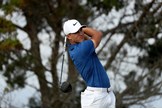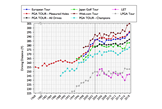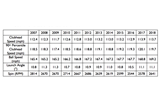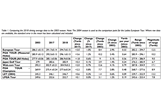R&A and USGA’s annual driving report shows another increase in distance
Published: Last updated:
The R&A and USGA’s 2018 annual driving distance report shows yet another increase in driving distance across the seven worldwide tour’s over the past year
The latest distance report confirms what most already knew – professionals, and amateurs, are hitting the ball further than before.
The annual driving distance report produced by the R&A and USGA contains facts and figures condensed in to 24 pages, and covers all seven worldwide tours and the amateur game.
> Read the full distance report here
The newest data shows that driving distances on the seven worldwide tours has once again increased, this time by an average of 1.7 yards – beyond the previous year’s gain of more than 3 yards.
That equated to an average increase of nearly 4 yards on the PGA Tour (Measured Holes), 3 yards on the European Tour and 2 yards on the Web.Com Tour – which has seen the biggest increase over the past 15 years, of 17.1 yards from 2003 to 2018.

The Web.Com also produced the longest average driving distance, increasing from 302.9 to 304.9 yards, in addition to the lowest scoring average – the only tour to have an average score of less than 71.
The smallest increase in driving distance was on the LPGA Tour, which went from 252.6 yards to 252.7 yards in the past year.

In addition to driving distance, the governing bodies have been tracking launch conditions on the PGA Tour since 2007, and have noticed marked differences over the past 11 years.
Average clubhead speed has increased by 1.3 mph from 2007 to 2018 and ball speed by 3.8mph. That number was 0.4mph ball speed increase from 2017 – 2018, although there was a decrease of 0.2mph clubhead speed.
Launch angle in 2018 is 0.3° higher than the 2007 value, while spin is 173 rpm lower in 2018. It is also noteworthy that the launch condition set-up for the Overall Distance Standard is 10° and 2520 rpm at a clubhead speed of 120 mph.

Key Conclusions: Driving Distance Report
Within the appendix of the driving distance report, the R&A and USGA cemented their position that “any further significant increases in hitting distances at the highest level are undesirable.”
“Whether these increases in distance emanate from advancing equipment technology, greater athleticism of players, improved player coaching, golf course conditioning or a combination of these or other factors, they will have the impact of seriously reducing the challenge of the game.”
Here are four of the key takeaways from the report:
#1: Don’t expect any difference in equipment rules for professionals and amateurs
“The R&A and USGA continue to believe that the retention of a single set of rules for all players of the game, irrespective of ability, is one of golf’s greatest strengths. The R&A and USGA regard the prospect of having permanent separate rules for elite competition as undesirable and have no current plans to create separate equipment rules for highly skilled players.”
#2: There aren’t plans to make any changes to the rules surrounding the golf ball
“Golf balls used by the vast majority of highly skilled players today have largely reached the performance limits for initial velocity and overall distance which have been part of the Rules since 1976. The governing bodies believe that golf balls, when hit by highly skilled golfers, should not of themselves fly significantly further than they do today. In the current circumstances, the R&A and the USGA are not advocating that the Rules relating to golf ball specifications be changed other than to modernise test methods.”
#3: The rules on new equipment may be about to get stricter
“The R&A and the USGA are concerned that, on an increasing number of occasions, new products are being developed and marketed which potentially run counter to the principles expressed in this statement. These product launches, without prior consultation with the governing bodies, can lead to considerable difficulties in formulating appropriate equipment rules and to undesirable conflicts 2018 Distance Report between manufacturers and rule makers. The R&A and the USGA intend to bring forward proposals designed to improve procedures for the approval of new products.”
#4: They are adament that courses should not continue to get longer
“The consequential lengthening or toughening of courses would be costly or impossible and would have a negative effect on increasingly important environmental and ecological issues. Pace of play would be slowed and playing costs would increase.”




